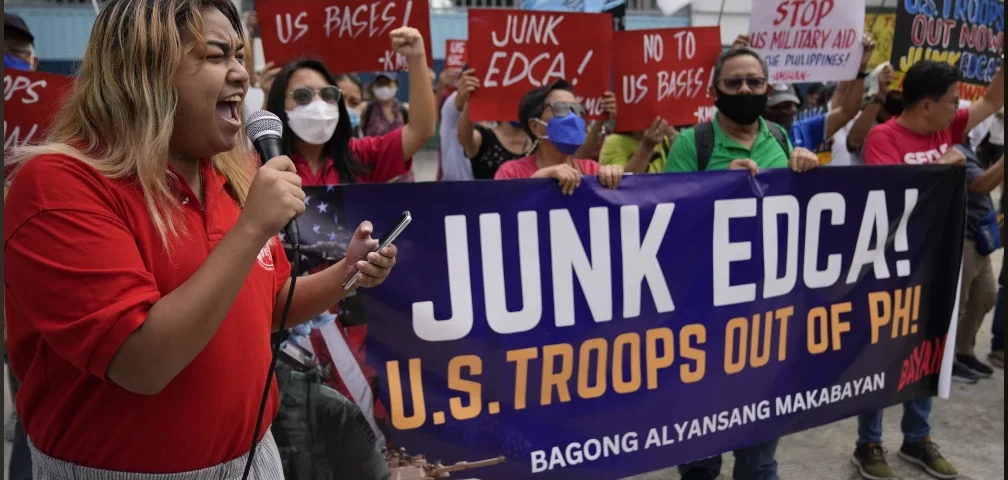U.S. Secretary of Defense, and former Raytheon board member, Lloyd Austin visited the Philippines, where he met with President Ferdinant Marcos Jr. on Feb. 1 to announce the expansion of the U.S. military presence there, from five to nine bases. The expansion and establishment of these bases are allowed under the Enhanced Defense Cooperation Agreement (EDCA).
This announcement has sparked outrage among the people of the Philippines, who held mass demonstrations in 1991 and shut down Clark Air Base and Subic Naval Base, which had been used to support the U.S. war of aggression against Vietnam.
The Filipino people have fought hard for more than a century against U.S. colonialism. During the Philippine-American war, the U.S. military slaughtered more than a million people. The 124th anniversary of the war, which began Feb. 4, 1899, coincided with Secretary Austin’s visit to Manilla.
BAYAN USA Call to Action
Ten days after President Marcos and Secretary Austin met, activists and allies of the national-democratic movement of the Philippines mobilized for a Call to Action, which was put out by BAYAN USA.
Rallies hit the streets demanding an end to the EDCA, expulsion of all U.S. troops from Philippine territory, the end of all joint U.S.-Philippine military exercises, the end of all U.S. military aid to the armed forces and police of the Philippines and an end to the colonial relationship of the country to the U.S.
This writer spoke to LRT, an organizer with BAYAN Seattle, who shared their thoughts on the U.S. military expansion:
“The presence of the U.S. military carries a dual purpose of maintaining the semicolonial system in the Philippines and ensuring its guns remain aimed at China. There is no regard for the people or the environment, as the U.S. Navy has historically polluted local waters and damaged coral reefs, affecting the marine life and disrupting the livelihood of fisherfolk.
“Everywhere there has been a U.S. military base, there has also been a red-light district. The tourism of military personnel isn’t just at night clubs and local clubs. The violence against Filipina women intensifies with the presence of military personnel, as evidenced by the 2014 murder of Jennifer Laude by U.S. Marine Joseph Pemberton.”
Although Pemberton was imprisoned first in a Philippine jail, he was ultimately released to U.S. custody. Today he walks free in Hawaii with no justice for the Laude family.
LRT continued:
“It is the U.S. Special Forces that train the murderous butchers in the Armed Forces of the Philippines to inflict harm on our communities in the name of ‘counterinsurgency’ and ‘anti-terrorism.’ Who better to teach the AFP to terrorize its own people than the number-one terrorist in the world?”
U.S. increases bases, threats to China
These newly secured bases were the missing link in completing what is referred to as the “first island chain” in the U.S.-military enclosure of China. These bases are situated on the land sites closest to Taiwan. As Washington builds up U.S. forces in the region for war against China, supplies and nuclear weapons could be stored on these bases.
With a U.S./NATO-instigated proxy war in Ukraine in full-swing, justified under the auspices of “protecting” Ukraine, and with the U.S. showing no desire to de-escalate, there is no reason to believe joint-access military base expansion would protect the Philippines. U.S. maneuvers in the region have threatened aggression against China. The presence of additional U.S. military personnel only puts the Philippines in the crossfire.
*Featured Image: Demonstrators shout slogans as they protest against the visit of U.S. Defense Secretary Lloyd Austin III who is in the country for talks about deploying U.S. forces and weapons in more Philippine military camps during a rally outside Camp Aguinaldo military headquarters in metro Manila, Philippines on Feb. 2, 2023. The U.S. has been rebuilding its military might in the Philippines after more than 30 years and reinforcing an arc of military alliances in Asia in a starkly different post-Cold War era when the perceived new regional threat is an increasingly belligerent China. (AP Photo/Aaron Favila, File)
To access BAYAN USA’s press release against the U.S. military presence in the Philippines, go to facebook.com/bayanusapage/.
